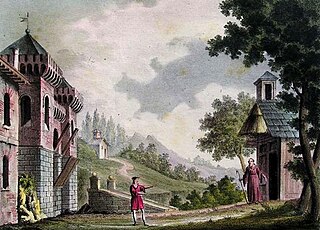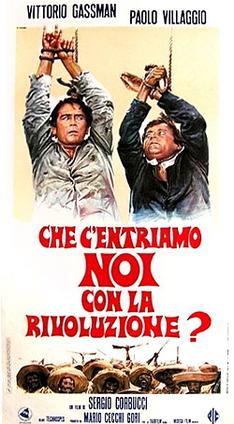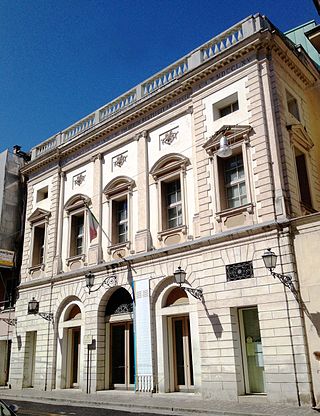
The Teatro Comunale di Bologna is an opera house in Bologna, Italy. Typically, it presents eight operas with six performances during its November to April season.

The Teatro Regio is a prominent opera house and opera company in Turin, Piedmont, Italy. Its season runs from October to June with the presentation of eight or nine operas given from five to twelve performances of each.

The Teatro Lirico is a theatre in Milan, Italy. In the 19th and early 20th centuries it hosted numerous opera performances, including the world premieres of Donizetti's L'elisir d'amore and Giordano's Fedora. The theatre, located on Via Rastrelli, closed in 1998. However, a restoration project was begun in April 2007, and it has finally re-opened in December 2021 as the Teatro Lirico Giorgio Gaber. Stage Entertainment carried on the renovation of the Theatre, completing all finishes and all workings started by the administration "Comune di Milano".

Teatro Margherita is a former theatre in the city of Bari, Apulia on the east coast of Italy. Its predecessor, a wooden structure called Varietà Margherita opened on September 5, 1910. From 1912–1914, a new theatre was erected by architect Francesco De Giglio. It opened in 1914.

Piazza De Ferrari is the main square of Genoa. Situated in the heart of the city between the historical and the modern center, Piazza De Ferrari is renowned for its fountain, which was restored in recent years along with a major restyling of the square.

The Teatro Opera is a prominent cinema and theatre house in Buenos Aires, Argentina.

The Teatro San Benedetto was a theatre in Venice, particularly prominent in the operatic life of the city in the 18th and early 19th centuries. It saw the premieres of over 140 operas, including Rossini's L'italiana in Algeri, and was the theatre of choice for the presentation of opera seria until La Fenice was built in 1792.

The Teatro Petruzzelli is the largest theatre of the city of Bari and the fourth Italian theatre by size.

What Am I Doing in the Middle of a Revolution? is a 1972 Spaghetti Western comedy film.

Teatro San Ferdinando is a theatre in Naples, Italy. It is named after King Ferdinand I of Naples. Located near Ponte Nuovo, it is to the southeast of the Teatro Totò in the western part of the neighborhood of Arenaccia. Built in the late eighteenth century, the seats are arranged in four box tiers, and the pit. It is most associated with Eduardo De Filippo and the productions of the 1950s under his direction. Closed in the 1980s and reopened in 2007, the San Fernando is managed by the Teatro Stabile of Naples.
John Randolph Pepper is a photographer and theatre director.

The Teatro Adriano, also known as Politeama Adriano and Cinema Adriano, is a cinema and former theatre located in Piazza Cavour, Rome, Italy.

The Teatro Flavio Vespasiano is the main theatre and opera house in Rieti. It was opened on 20 September 1983, after ten years of work and finishing touches; directed by architect Achille Sfondrini. It takes its name from the Roman emperor Titus Flavius Vespasian who was born in sabina.

Carlo Cataldo was an Italian historian, poet, and teacher.
The following is a timeline of the history of the city of Catania in the Sicily region of Italy.

The Castle of the Pico is a castle in the city center of Mirandola, in the province of Modena, Italy.

Eliodoro Bianchi was an Italian operatic tenor and later a prominent singing teacher. Born in Cividate al Piano and trained in Naples under Giacomo Tritto, he made his stage debut in 1793. Amongst the many roles, he created during the course of his 40-year career were Baldassare in Ciro in Babilonia and the King of Sweden in Eduardo e Cristina, both of which were composed by Rossini expressly for Bianchi's voice. He retired from the stage in 1835 and spent his later years in Palazzolo sull'Oglio, where he died at the age of 75.

The Sala Lancisiana is a renaissance building located in Rome, part of the hospital of San Giacomo degli Incurabili, and site of an anatomical theatre. It was built at the end of the 16th century by the architect Francesco Capriani at the behest of Cardinal Anton Maria Salviati, and named after the physician Giovanni Maria Lancisi.

The Teatro Mario Del Monaco is an opera house and theatre in Treviso, Italy. It was previously known as the Teatro Onigo from 1692 to 1846, the Teatro Sociale from 1847 to 1930, and the Teatro Comunale from 1931 to 2011. In 2011, it was renamed in honour of the Italian tenor Mario Del Monaco who lived in Treviso from 1975 until his death in 1982. It is located in the historic centre of the city on the Corso del Popolo and since 2019 has been run by the Teatro Stabile del Veneto which also runs the Teatro Goldoni in Venice and the Teatro Verdi in Padua.

The Principal Theatre of Pontevedra (Teatro Principal de Pontevedra) is a theatre in the old town of Pontevedra (Spain).

















